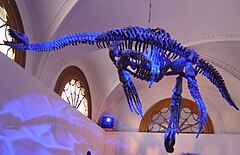Tuarangisaurus
Tuarangisaurus keyesi
Tuarangisaurus (Māori : tuarangi « ancien » + grec : σαῦρος, romanisé : sauros « lézard ») est un genre éteint d'élasmosauridés connus de Nouvelle-Zélande. Le type et la seule espèce connue est Tuarangisaurus keyesi, nommée en 1986 par Joan Wiffen et William L. Moisley (d)[1],[2].
Découverte
[modifier | modifier le code]Tuarangisaurus est connu de l'holotype NZGS CD425, un crâne et une mandibule presque complets, et de NZGS CD426, les neuf vertèbres cervicales les plus antérieures. Certains restes post-crâniens de juvéniles ont également été attribués à Tuarangisaurus[1]. Il a été collecté dans le membre de grès de Maungataniwha de la formation de Tahora, datant du Campanien supérieur au Maastrichtien inférieur du Crétacé supérieur[2].
Une deuxième espèce, T. australis, a été nommée en 2005[3] ; cependant, il a été déplacé vers le genre Eromangasaurus en 2007, devenant le synonyme principal d'E. carinognathus[4]. Une troisième espèce, T. ? cabazai, a également été référé à Tuarangisaurus par la description originale[1] ; cependant, il a été récemment réaffecté à une aristonectine indéterminée[5].
En 2018, Otero et al. ont rapporté un spécimen juvénile qui indiquait l'ontogénie de ce plésiosaure. Le spécimen avait de nombreuses caractéristiques communes avec l'holotype, mais il différait par l'orientation du maxillaire ainsi que par le nombre de dents présentes[6].
Description
[modifier | modifier le code]Tuarangisaurus mesurait 8 mètres de long et pesait une tonne[7]. Il se distingue de tous les autres élasmosauridés connus par une combinaison unique de caractéristiques ainsi que par deux traits autrement inconnus : l'ectoptérygoïde a un long processus dirigé vers le dos et un gros bossage osseux en dessous. Un étrier est présent dans l'holotype; cet os était auparavant considéré comme absent des élasmosauridés[2],[8].
Classification
[modifier | modifier le code]Tuarangisaurus a été initialement attribué aux Elasmosauridae[1] ; une étude a révélé qu'il s'agissait d'un proche parent de Callawayasaurus[9]. Une nouvelle analyse phylogénétique des plésiosaures en 2016 a réaffirmé que Tuarangisaurus était un élasmosauridé, mais a rejeté une relation étroite avec Callawayasaurus.
Le cladogramme suivant est modifié à partir de Rodrigo A. Otero (d) et Sergio Soto-Acuña (d), (2020)[10] :
| Elasmosauridae |
| |||||||||||||||||||||||||||||||||||||||||||||||||||||||||||||||||||||||||||||||||||||||||||||||||||||||||||||||||||||
Le cladogramme ci-dessous ne montre que les relations internes au sein des Elasmosauridae, sur la base des résultats de José Patricio O’Gorman et al. (2015) qui ont mené l'analyse phylogénétique la plus complète à ce jour (2022) en se concentrant sur les élasmosauridés[11].
| ◄ Elasmosauridae |
| |||||||||||||||||||||||||||||||||||||||||||||||||||||||||||||||||||||||||||||||||||||||||||||||||||||||||||||||
Les analyses précédentes de 2013[12] et 2016[13] donnaient :
| |||||||||||||||||||||||||||||||||||||||||||||||||||||||||||||||||||||||||
| Cryptoclidia |
| |||||||||||||||||||||||||||||||||||||||||||||||||||||||||||||||||||||||||||||||||||||||||||||||||||||||||
Liens externes
[modifier | modifier le code]- Ressources relatives au vivant :
Notes et références
[modifier | modifier le code]- J. Wiffen et W.L. Moisley, « Late Cretaceous reptiles (Families Elasmosauridae and Pliosauridae) from the Mangahouanga Stream, North Island, New Zealand », New Zealand Journal of Geology and Geophysics, vol. 29, no 2, , p. 205–252 (DOI 10.1080/00288306.1986.10427535)
- J.P. O'Gorman, R.A. Otero, N. Hiller, J. Simes et M. Terezow, « Redescription of Tuarangisaurus keyesi (Sauropterygia; Elasmosauridae), a key species from the uppermost Cretaceous of the Weddellian Province: Internal skull anatomy and phylogenetic position », Cretaceous Research, vol. 71, , p. 118–136 (DOI 10.1016/j.cretres.2016.11.014)
- ↑ S. Sachs, « Tuarangisaurus australis sp. nov. (Plesiosauria: Elasmosauridae) from the Lower Cretaceous of northeastern Queensland, with additional notes on the phylogeny of the Elasmosauridae », Memoirs of the Queensland Museum, vol. 50, no 2, , p. 425–440 (lire en ligne [archive du ])
- ↑ Benjamin P. Kear, « Taxonomic clarification of the Australian elasmosaurid genus Eromangasaurus, with reference to other austral elasmosaur taxa », Journal of Vertebrate Paleontology, vol. 27, no 1, , p. 241–246 (DOI 10.1671/0272-4634(2007)27[241:TCOTAE]2.0.CO;2)
- ↑ J.P. O'Gorman, Z. Gasparini et L. Salgado, « Reappraisal of Tuarangisaurus? cabazai (Elasmosauridae, Plesiosauria) from the Upper Maastrichtian of northern Patagonia, Argentina », Cretaceous Research, vol. 47, , p. 39–47 (DOI 10.1016/j.cretres.2013.10.003)
- ↑ R.A. Otero, J.P. O'Gorman, W.L. Moisley, M. Terezow et J. Mckee, « A juvenile Tuarangisaurus keyesi Wiffen and Moisley, 1986 (Plesiosauria, Elasmosauridae) from the Upper Cretaceous of New Zealand, with Remarks on Its Skull Ontogeny », Cretaceous Research, vol. 85, , p. 214–231 (DOI 10.1016/j.cretres.2017.09.007)
- ↑ Gregory S. Paul, The Princeton Field Guide to Mesozoic Sea Reptiles, Princeton University Press, , 116 p. (ISBN 9780691193809)
- ↑ K. Carpenter, « Revision of North American elasmosaurs from the Cretaceous of the western interior », Paludicola, vol. 2, , p. 148–173
- ↑ T. Kubo, M.T. Mitchell et D.M. Henderson, « Albertonectes vanderveldei, a new elasmosaur (Reptilia, Sauropterygia) from the Upper Cretaceous of Alberta », Journal of Vertebrate Paleontology, vol. 32, no 3, , p. 557–572 (DOI 10.1080/02724634.2012.658124, S2CID 129500470)
- ↑ Rodrigo A. Otero et Sergio Soto-Acuña, « Wunyelfia maulensis gen. et sp. nov., a new basal aristonectine (Plesiosauria, Elasmosauridae) from the Upper Cretaceous of central Chile », Cretaceous Research, vol. 188, , p. 104651 (DOI 10.1016/j.cretres.2020.104651, Bibcode 2021CrRes.11804651O, S2CID 224975253)
- ↑ (en) José P. O’Gorman, Leonardo Salgado, Eduardo B. Olivero et Sergio A. Marenssi, « Vegasaurus molyi, gen. et sp. nov. (Plesiosauria, Elasmosauridae), from the Cape Lamb Member (lower Maastrichtian) of the Snow Hill Island Formation, Vega Island, Antarctica, and remarks on Wedellian Elasmosauridae », Journal of Vertebrate Paleontology, vol. 35, , e931285 (DOI 10.1080/02724634.2014.931285).
- ↑ (en) Roger B. J. Benson, Hilary F. Ketchum, Darren William Naish et Langan E. Turner, « A new leptocleidid (Sauropterygia, Plesiosauria) from the Vectis Formation (Early Barremian–early Aptian; Early Cretaceous) of the Isle of Wight and the evolution of Leptocleididae, a controversial clade », Journal of Systematic Palaeontology, vol. 11, no 2, , p. 233–250 (DOI 10.1080/14772019.2011.634444, Bibcode 2013JSPal..11..233B, S2CID 18562271)
- ↑ (en) Rodrigo A. Otero, « Taxonomic reassessment of Hydralmosaurus as Styxosaurus: new insights on the elasmosaurid neck evolution throughout the Cretaceous », PeerJ, vol. 4, , e1777 (PMID 27019781, PMCID 4806632, DOI 10.7717/peerj.1777)
